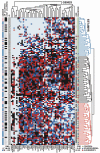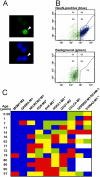DNA methylation in the human cerebral cortex is dynamically regulated throughout the life span and involves differentiated neurons
- PMID: 17878930
- PMCID: PMC1964879
- DOI: 10.1371/journal.pone.0000895
DNA methylation in the human cerebral cortex is dynamically regulated throughout the life span and involves differentiated neurons
Abstract
The role of DNA cytosine methylation, an epigenetic regulator of chromatin structure and function, during normal and pathological brain development and aging remains unclear. Here, we examined by MethyLight PCR the DNA methylation status at 50 loci, encompassing primarily 5' CpG islands of genes related to CNS growth and development, in temporal neocortex of 125 subjects ranging in age from 17 weeks of gestation to 104 years old. Two psychiatric disease cohorts--defined by chronic neurodegeneration (Alzheimer's) or lack thereof (schizophrenia)--were included. A robust and progressive rise in DNA methylation levels across the lifespan was observed for 8/50 loci (GABRA2, GAD1, HOXA1, NEUROD1, NEUROD2, PGR, STK11, SYK) typically in conjunction with declining levels of the corresponding mRNAs. Another 16 loci were defined by a sharp rise in DNA methylation levels within the first few months or years after birth. Disease-associated changes were limited to 2/50 loci in the Alzheimer's cohort, which appeared to reflect an acceleration of the age-related change in normal brain. Additionally, methylation studies on sorted nuclei provided evidence for bidirectional methylation events in cortical neurons during the transition from childhood to advanced age, as reflected by significant increases at 3, and a decrease at 1 of 10 loci. Furthermore, the DNMT3a de novo DNA methyl-transferase was expressed across all ages, including a subset of neurons residing in layers III and V of the mature cortex. Therefore, DNA methylation is dynamically regulated in the human cerebral cortex throughout the lifespan, involves differentiated neurons, and affects a substantial portion of genes predominantly by an age-related increase.
Conflict of interest statement
Figures





References
-
- Tsankova N, Renthal W, Kumar A, Nestler EJ. Epigenetic regulation in psychiatric disorders. Nat Rev Neurosci. 2007;8:355–367. - PubMed
-
- Petronis A. Human morbid genetics revisited: relevance of epigenetics. Trends Genet. 2001;17:142–146. - PubMed
-
- Bird A. Perceptions of epigenetics. Nature. 2007;447:396–398. - PubMed
-
- Reik W. Stability and flexibility of epigenetic gene regulation in mammalian development. Nature. 2007;447:425–432. - PubMed
-
- Ausio J, Levin DB, De Amorim GV, Bakker S, Macleod PM. Syndromes of disordered chromatin remodeling. Clin Genet. 2003;64:83–95. - PubMed
Publication types
MeSH terms
Substances
LinkOut - more resources
Full Text Sources
Other Literature Sources
Medical
Research Materials
Miscellaneous

